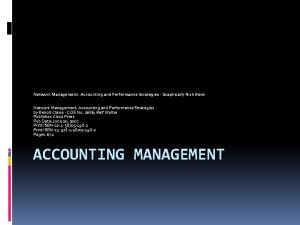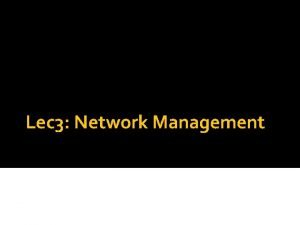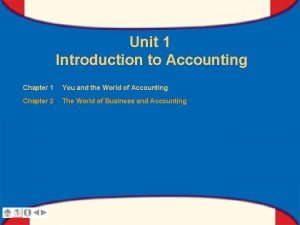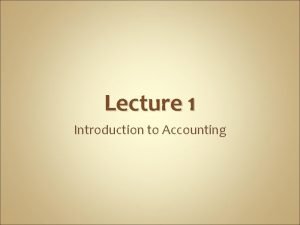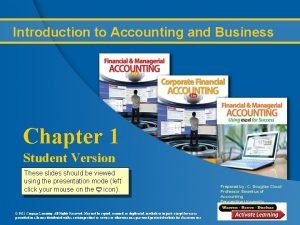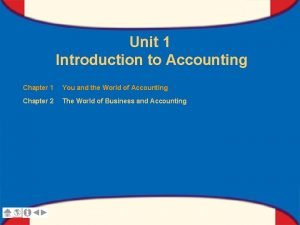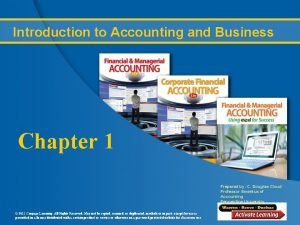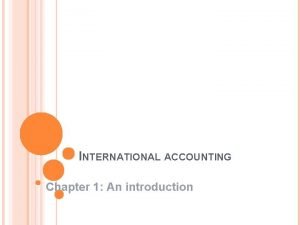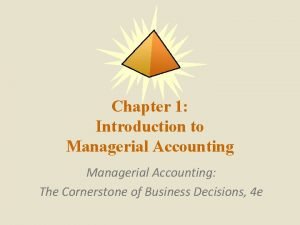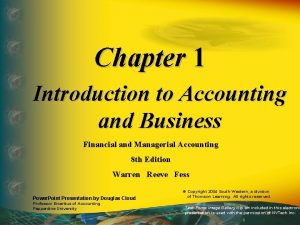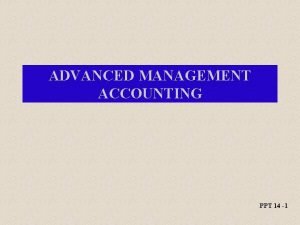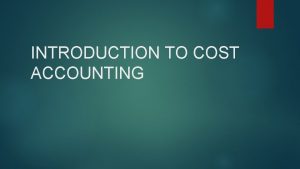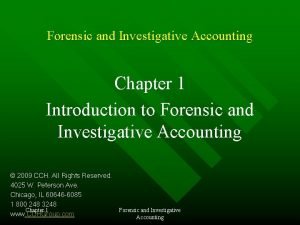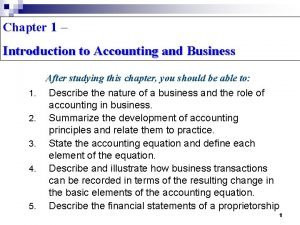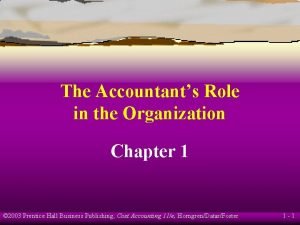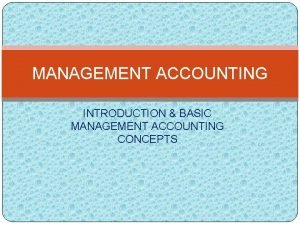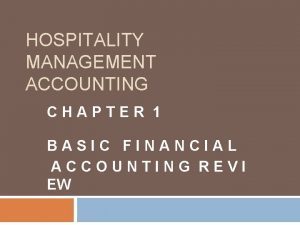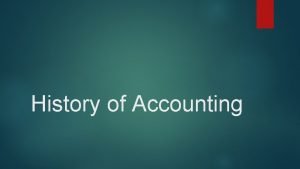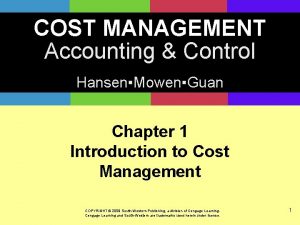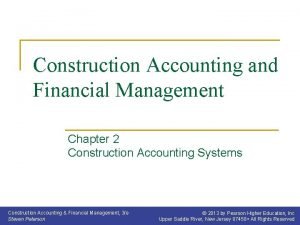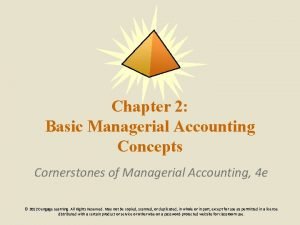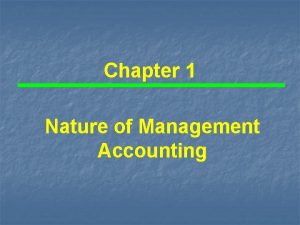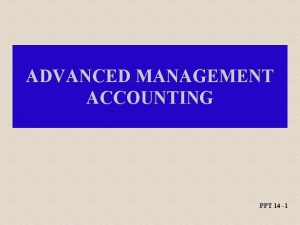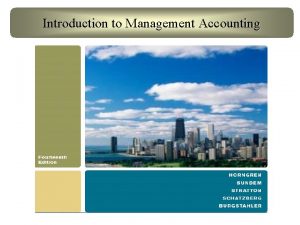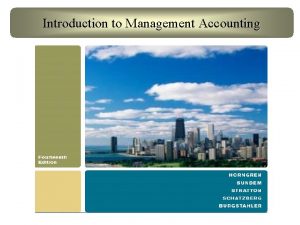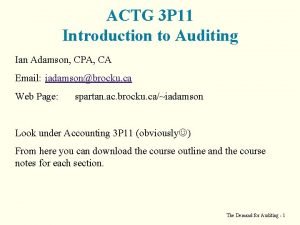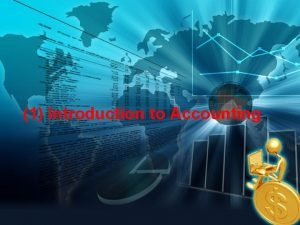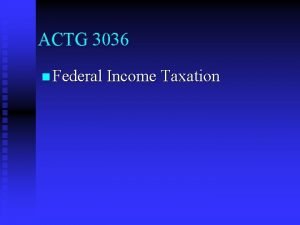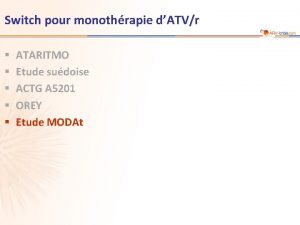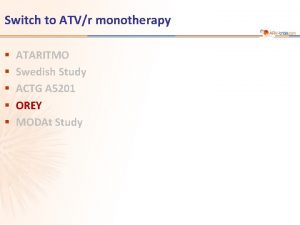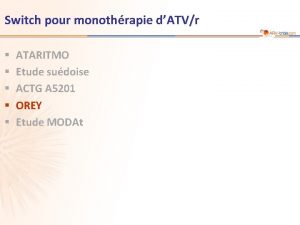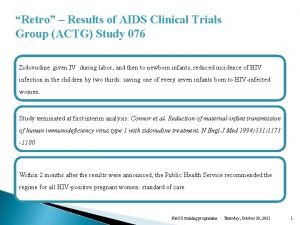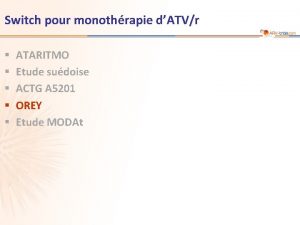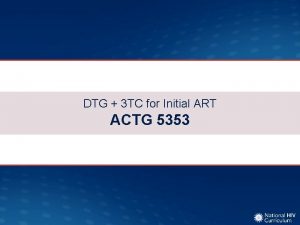ACTG 2 P 12 Introduction to Management Accounting









































- Slides: 41

ACTG 2 P 12 -Introduction to Management Accounting Today’s experience will focus on ensuring that you have a clear understanding of goals and objectives of this course • • Who are we and why are we here? What are your expectations of this course? What is Management Accounting? What do we hope to cover in the next 14 weeks?

Definition of Management Accounting The Institute of Management Accountants (IMA): “The process of identification, measurement, accumulation, analysis, preparation, interpretation, and communication of financial (and non financial) information used by management to plan, evaluate, and control within the organization and to assure appropriate use and accountability for its resources.

Comparison of Management and Financial Accounting Areas of Comparison Management Accounting Financial Accounting Report format Flexible format, driven by user's needs Based on generally accepted accounting principles Purpose of reports Provides information for planning, control, performance measurement, and decision making Report on past performance Primary users Employees, managers, suppliers Owners, lenders, customers, government agencies

Comparison of Management and Financial Accounting Areas of Comparison Management Accounting Financial Accounting Units of measure Historical or future dollar; physical measure in time or number of objects Historical dollar Nature of information Future-oriented; objective for decision making; more subjective for planning; relies on estimates Historical, objective Frequency of reports Prepared as needed; may or may not be on a regular basis Prepared on a regular basis (minimum of once a year)

The Functions of Management Planning Acting (Executing) Feedback (Reporting) Controlling (Reviewing)

The Management Cycle • Traditionally, management operates in four stages: 1. Planning 4 Long and short term. 4 To support decision-making and set expectations. 2. Executing 4 Hiring, scheduling, acquiring assets (including inventory), reducing waster, generating revenues. 3. Reviewing 4 Controlling operations. 4 Comparing actual performance to plan. 4. Reporting 4 To stockholders, creditors, other managers, other interested parties.

The Management Cycle

Meeting Demands of Global Competition Identify major trends in the business environment, and use cost-benefit analysis to make business decisions.

Shift to a Service Economy In Canada, 57% of the workforce is employed in service companies.

Competing in the Global Marketplace Foreign operations account for over 30% of GE’s revenues, but generate two-thirds of the profit.

E-commerce • Conducting everyday business practices such as budgeting, planning, purchasing, and selling using the Internet. • Business-to-business E-commerce. • Important means of supply chain management.

New Management Philosophies • Three significant new management philosophies are as follows: 1. Just-in-time (JIT) operating environment. 2. Total quality management (TQM). 3. Activity-based management (ABM).

Just-in-Time • JIT philosophy means that the company schedules production just in time to satisfy needs. • Speeding up of the production process reduces throughput time. • Throughput time is the time between buying raw materials and selling the finished products.

Total Quality Management • The goal of total quality management (TQM) is to attract customers by providing them with superior products and services. • TQM emphasizes educating, training, and cross-training employees. • Quality improvement programs cost money today. • The benefits usually do not occur until later.

Theory of Constraints • Identify performance or production bottlenecks (limiting factors). • Overcome limitation. • Identify next bottleneck.

The Continuous Improvement Environment

The Goal: Continuous Improvement • • Avoid complacency. Constantly seek a better method. Reduce defects or poor quality. Reduce or eliminate non value-adding activities. Results: Product/service costs and delivery times reduced. Quality and customer satisfaction increases.

Examples of Performance Measures • Financial performance measures: 1. Return on investment. 2. Net income as a percentage of sales. 3. Costs of poor quality as a percentage of sales. • Non-financial performance measures: 1. Number of customer complaints. 2. Hours of inspection. 3. Time to fill an order.

Performance Measures • Performance measures are useful in reducing waste in operating activities. • Management uses performance measures in all stages of the management cycle. – In planning to motivate. – In executing to guide, and assign costs. – In reviewing to improve future performance. – In reporting to communicate results.

The Balanced Scorecard • A framework that links the perspective of stake holder groups – – Financial Perspective (investors) Learning and Growth Perspective (employees) Internal Business Perspective (managers/employees) Customer Perspective (customers) with the organization’s mission, vision, plans, and resources. • Provides clear, measurable performance targets.

Analysis of Non-financial Data – Bank Kings Beach National Bank Summary of Number of Customers Served For the Quarter Ended December 31, 20 xx Part A Number of Customers Served October November December Quarter Totals 1 5, 428 5, 186 5, 162 15, 776 2 5, 280 4, 820 4, 960 15, 060 3 4, 593 4, 494 4, 580 13, 667 Totals 15, 301 14, 500 14, 702 44, 503 Window

Analysis of Non-financial Data – Bank Kings Beach National Bank Summary of Number of Customers Served For the Quarter Ended December 31, 20 xx Part B Window Number of Customers Served per Hour Quarter Averages October November December 1 31. 93 30. 51 30. 36 30. 93 2 31. 06 28. 35 29. 18 29. 53 3 27. 02 26. 44 26. 94 26. 80 Totals 90. 01 85. 30 86. 48 87. 26

The Four W’s • Report preparation depends on: – Why? • Why are we preparing the report? – What? • What information is needed? – Who? • Who is the audience for the report? – When? • When is the report due?

Service, Merchandising, and Manufacturing Organizations

Service Organizations provides intangible services, rather than tangible products • Sells services, not products • No inventory accounts in the balance sheet • Use cost of services sold instead of cost of goods sold Cost of Sales = Net Cost of Services Sold

Merchandising Organizations resells products previously purchased from suppliers • Purchases products that are ready for sale • Maintains one inventory account on balance sheet • Include cost of purchases in cost of goods sold Cost of Goods Sold = Beginning merchandise inventory + Net cost of purchases - Ending merchandise inventory

Manufacturing Organizations uses labour and factory assets to shape raw materials into finished products • Designs and manufactures products for sale • Maintains three inventory accounts – (1) Material inventory – (2) Work in process inventory – (3) Finished goods inventory • Include cost of goods manufactured in cost of goods sold Cost of Goods Sold = Beginning finished goods inventory + Cost of goods manufactured - Ending finished goods inventory

Income Statement Format Sales Revenue deduct when sales occur Cost of Goods Sold or Cost of sales equals Gross Margin deduct Period Costs Operating Expenses equals Operating Income Or Net Income

Financial Statements for Service Organizations • There is no inventory and thus no inventoriable costs. • The income statement does not include cost of goods sold. Revenues – Expenses = Operating income

Financial Statements for Merchandising Companies BALANCE SHEET Inventoriable Costs Purchases of Inventory plus Freight-In INCOME STATEMENT Sales Revenue Inventory when sales occur deduct Cost of Goods Sold equals Gross Margin deduct Operating Period Costs Expenses equals Operating Income

Financial Statements for Manufacturing Companies BALANCE SHEET INCOME STATEMENT Inventoriable Costs Materials Inventory Work in Process Inventory Sales Revenue Finished Goods Inventory when sales occur deduct Cost of Goods Sold equals Gross Margin deduct Operating Period Costs Expenses equals Operating Income

Comparison of Financial Statements for Service, Merchandising, and Manufacturing Organizations

Ethics Use reasonable standards to make ethical judgments.

Professional Ethics for Management Accountants • In many situations the ethical path is not so clear. • The Society of Management Accountants of Canada (CMA Canada) has developed standards to help management accountants deal with these situations.

Standards of Ethical Conduct for Management Accountants Competence Integrity Confidentiality Objectivity

Competence Standards • Develop knowledge and skills on an ongoing basis. • Perform duties in accordance with relevant laws and technical standards. • Prepare complete and clear reports after appropriate analysis of information.

Confidentiality Standards • Refrain from disclosing confidential information. • Make sure that subordinates refrain from disclosing confidential information. • Refrain from using confidential information for unethical or illegal advantage.

Integrity Standards • Avoid actual or apparent conflicts of interest. • Avoid activities that would prejudice one’s ability to carry out duties ethically. • Refuse any gift or favor that might influence one’s actions. • Avoid activities that could discredit the profession.

Integrity Standards • Avoid activities that could threaten the organization’s legitimate and ethical objectives. • Acknowledge any professional limitations relative to the performance of one’s job. • Communicate both favorable and unfavorable information and opinions.

Objectivity Standards • Communicate information fairly and objectively. • Disclose fully all relevant information to users.

Resolution of Ethical Conflict • Follow organizational policies. • If these do not resolve the conflict: – Discuss with the immediate superior, or next higher level authority involved. (Do not communicate with external parties. ) – Clarify issues with an objective advisor. – Consult your own attorney about legal obligations and rights. – If ethical issues cannot be resolved, consider resignation.
 Actg 2p12
Actg 2p12 Responsibility centers in management accounting
Responsibility centers in management accounting Accounting management in network management
Accounting management in network management Public switched telephone network notes
Public switched telephone network notes Accounting management in network management
Accounting management in network management Financial accounting chapter 1
Financial accounting chapter 1 Computerized accounting information system
Computerized accounting information system Conservatism in accounting
Conservatism in accounting Unit 1 introduction to accounting
Unit 1 introduction to accounting Accounting in business chapter 1
Accounting in business chapter 1 Accounting assumptions are
Accounting assumptions are Accounting in business chapter 1
Accounting in business chapter 1 Introduction to accounting information systems
Introduction to accounting information systems Unit 1 introduction to accounting
Unit 1 introduction to accounting Asa accounting
Asa accounting Introduction to accounting and business chapter 1
Introduction to accounting and business chapter 1 Introduction to international accounting
Introduction to international accounting Management accounting chapter 1
Management accounting chapter 1 Chapter 1 introduction to accounting and business
Chapter 1 introduction to accounting and business Public sector accounting notes
Public sector accounting notes Non value added activities ppt
Non value added activities ppt Cost accounting concept
Cost accounting concept Introduction to forensic accounting
Introduction to forensic accounting Comprises 70% of business entities in the united states
Comprises 70% of business entities in the united states Introduction to forensic accounting
Introduction to forensic accounting Top management middle management first line management
Top management middle management first line management Management pyramid
Management pyramid Middle level management
Middle level management The role of management accounting in scorekeeping involves:
The role of management accounting in scorekeeping involves: Management accounting meaning
Management accounting meaning Scheduled banks vs non scheduled banks
Scheduled banks vs non scheduled banks Nature and scope of accounting
Nature and scope of accounting Management accounting basics
Management accounting basics Materiality principle example
Materiality principle example Is luca pacioli a cpa
Is luca pacioli a cpa Management acc
Management acc Cost and management accounting chapter 1
Cost and management accounting chapter 1 Construction accounting and financial management
Construction accounting and financial management Examples of accounting database management system
Examples of accounting database management system Moh accounting
Moh accounting Nature of management accounting
Nature of management accounting Strategic management accounting ppt
Strategic management accounting ppt


